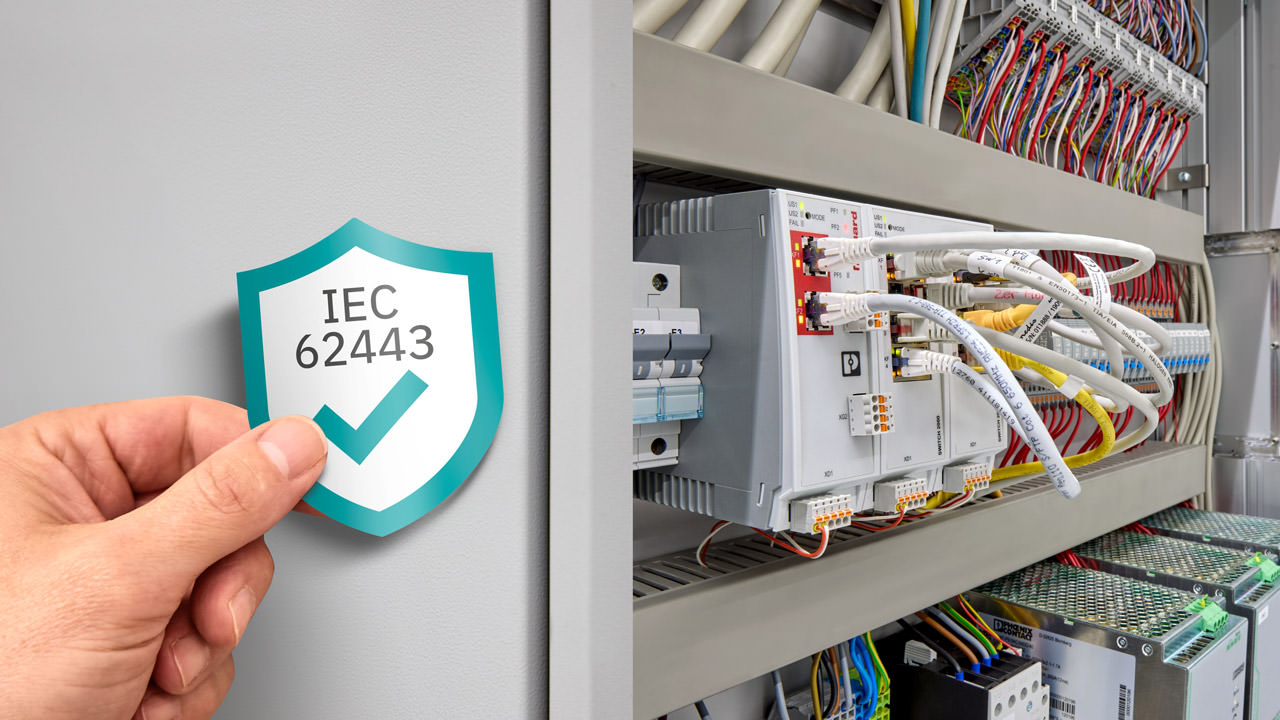TechnologyMay 19, 2025
Special Report 2025: State of Industrial Connectivity

Cybersecurity, IT/OT convergence, and the impact of AI are some of the megatrends that are shaping the state of industrial connectivity in 2025. Global organizations are establishing technical priorities for industrial networks today to identify opportunities, overcome challenges and improve collaboration for success.
INDUSTRIAL CONNECTIVITY HAS BECOME vitally important to the success of smart manufacturing worldwide. So for this special report, the Industrial Ethernet Book reached out industry experts to learn about the state of connectivity in modern manufacturing. Not surprisingly, we learned the focus is on hardware and software solutions, cybersecurity and technologies such as cloud integration, convergent TSN networking, wireless communications and the emergence of Single Pair Ethernet.
What seems certain is that connectivity—the ability of machines, devices, and systems in industrial environments to exchange data seamlessly and reliably across all levels of automation – is currently undergoing a major transformation driven by digitalization, the push toward smart manufacturing and the needs of the Industrial Internet of Things.

“Hyperconnectivity reflects the growing need to connect a wide range of devices and subsystems. In many industries, control-level components now connect to more than one higher-level system to maximize data availability and improve real-time decision-making.” — Ken YT Lee, Head of Moxa Serial Device Sever Segment.
Three pillars shaping evolution
Key technologies shaping factory connectivity focus on hyperconnectivity, interoperability, and cybersecurity.
According to Ken YT Lee, Head of Moxa Serial Device Sever Segment, the state of industrial connectivity including hardware and/or software solutions is evolving to provide greater levels of performance in smart manufacturing operations.
“Industrial connectivity is evolving rapidly to support the increasing demands of smart manufacturing,” Lee told the Industrial Ethernet Book recently. “Three key pillars are shaping this evolution: hyperconnectivity, interoperability, and cybersecurity.”
Lee said that hyperconnectivity reflects the growing need to connect a wide range of devices and subsystems. In many industries, control-level components now connect to more than one higher-level system to maximize data availability and improve real-time decision-making.
“Interoperability ensures different systems and protocols can communicate effectively. As factories integrate more heterogeneous devices, connectivity solutions must support multiple protocols and provide seamless protocol conversion to enable reliable data exchange,” Lee said.
And he added that “cybersecurity is becoming a core requirement. As physical connectivity and system integration increase, protecting systems and data is critical. New connectivity solutions must meet both internal security policies and external regulations. This means implementing security features directly into hardware and software to safeguard operations.”
These trends reflect a shift toward industrial networks that are more connected, more intelligent, and more secure, creating the foundation for long-term success in smart manufacturing.
Impact of cybersecurity
Lee said tht cybersecurity is currently one of the most important forces shaping the development of industrial connectivity. While many field devices are built for long service life and stable performance, they now face new challenges as they must comply with security standards such as IEC 62443.
This is particularly demanding for edge-layer components, which often use lightweight embedded systems. To meet the requirements, future products must be secure by design, including features like encrypted communication, user authentication, and secure firmware updates.
“At Moxa, we see this shift clearly. Connectivity solutions must now not only deliver reliable performance but also provide built-in protection against cyber threats. Technologies that support centralized user management, automated threat detection, and compliance with global standards are becoming essential,” Lee said.
“By integrating security at the design level, industrial networks can support the needs of modern automation while also protecting critical infrastructure from emerging risks.”
Key technical benefits
For cybersecurity benefits, the new edge connectivity solutions and components need to provide protected data streams and management interfaces only to authorized users. They must also be able to notify the system if any abnormal incident occurs.
This enables users to enforce a defense-in-depth strategy, starting from the edge layer and extending across the core industrial network. It supports cybersecurity policies such as a zero-trust approach and centralized management for IT/OT convergence, including enterprise user authentication and Security Information and Event Management (SIEM).
Moreover, in regions with stricter cybersecurity governance—such as NIS2 in Europe, which includes penalties for non-compliance—having secure edge connectivity products helps users meet audit requirements. These include protecting critical production data through authentication and encryption and fulfilling security incident reporting obligations. This requires detailed incident logging that captures full contextual information from the edge device, such as who was involved, what happened, when, where, why, and how.
Engineering challenges
“A growing challenge in industrial environments is the knowledge gap between traditional OT systems and the skills of younger engineers. Many new professionals are experienced with cloud platforms, cybersecurity, and AI, but less familiar with legacy technologies such as serial interfaces and industrial protocols,” Lee said.
He added that modern connectivity solutions are helping bridge this gap. They must be intuitive, easy to configure, and efficient to troubleshoot, especially for users without deep OT experience.
Moxa’s next generation secure serial-to-Ethernet device server NPort 6000-G2 is one example. It includes a built-in web interface that allows users to monitor live Ethernet and serial traffic directly in the browser. This removes the need for additional tools, such as managed switches for port mirroring or serial monitoring software and allows troubleshooting from any device with a browser.
This user-friendly design simplifies complex tasks, reduces downtime, and makes industrial systems more accessible. Looking ahead, this kind of innovation will support the next generation of engineers and help manufacturers move forward with their digital transformation goals.
Modernizing Serial Connectivity in Critical Infrastructure
Across sectors like gas, water, and energy, aging serial devices remain essential to operations. Connecting these assets securely to modern networks is now a key focus for engineers and operators.
Recommendations from Moxa’s field experience:
-

Moxa’s new NPort 6100/6200 G2 Series.
Choose plug-and-play serial-to-Ethernet solutions to reduce integration time and cost. Device servers with Real COM and TCP/UDP modes allow legacy devices like meters and gauges to connect with minimal disruption.
- Prioritize cybersecurity at the edge. Look for serial device servers with built-in protections such as Secure Boot, TLS/SSL encryption, RBAC, and compliance with IEC 62443-4-2 SL2.
- Simplify deployment and maintenance through centralized configuration, built-in diagnostics, and multi-port flexibility.
For engineers seeking to upgrade connectivity without replacing existing infrastructure, modern secure device servers, such as Moxa’s new NPort 6100/6200 G2 Series, offer a practical path forward.

“The digitalization and networking of production, product and customer data is the decisive factor for increasing the added value of companies and thus also a basis for the economic development of global regions. The EU Commission recognized this and published the EU cybersecurity strategy back in December 2020. It defines the requirements for resilience and attack defense for manufacturers of components and systems as well as for all major manufacturing companies. — Jörg Brasas, Strategic Product Marketing – Business Unit Automation Infrastructure, Phoenix Contact.
Advancing connectivity
Guided by cloud integration, convergent TSN networking, wireless communications and the emergence of Single Pair Ethernet.
According to Dipl.-Ing. Jörg Brasas, Strategic Product Marketing – Business Unit Automation Infrastructure, Phoenix Contact GmbH & Co. KG, the state of connectivity is being guided by cloud integration, convergent TSN networking, wireless communications and the emergence of Single Pair Ethernet.
Here is how Brasas summarized these factors and how they are affecting connectivity in the smart factory:
Seamless communication from the sensor to the cloud: The big goal is “seamless communication from the sensor to the cloud”, i.e. all data is available where it is needed in real time with minimal effort. The current state of industrial connectivity is that powerful network structures exist in OT today, but further challenges still need to be solved.
Convergent networks through TSN (Time-Sensitive Networking): TSN is a key technology for the convergence of networks. It enables the integration of different types of data traffic in a single network. Real-time critical applications (e.g. fast control, signal acquisition in energy networks or motion control) and data-intensive applications (e.g. video streams or IT systems) can be operated in parallel via one network.
Wireless real-time communication with 5G and Wi-Fi 6: 5G and Wi-Fi 6 are crucial for real-time wireless communication in smart factories. 5G offers ultra-reliable, low-latency communication (URLLC), which is essential for industrial applications such as controllers and actuators. Wi-Fi 6 complements this with high data rates and improved network performance in dense environments.
Integration of sensors and actuators through SPE (Single Pair Ethernet): SPE enables the simple and cost-effective integration of sensors and actuators into industrial networks. It offers reliable data transmission and power supply via a single line-line pair, which simplifies installation and maintenance and increases flexibility.
Technology solutions
“Industrial connectivity is driven by several key trends and specific technology solutions that significantly impact the performance of automation and machine networking,” Brasas told the Industrial Ethernet Book.
Important trends in automation are:
1. Industrial Internet of Things (IIoT): IIoT provides real-time information for better operational control and more efficient production. It optimizes maintenance processes, reduces downtimes and uses resources more efficiently. IIoT is scalable and adapts to your requirements. The aim of IIoT is to improve operational efficiency, reduce production costs, speed up processes and realize new business models. By networking machines, production facilities and manufacturing processes, data analyses are carried out to optimize productivity, efficiency and maintenance in production.
2. Edge Computing: Edge computing brings intelligence close to the machine and therefore close to the data source. These intelligent systems can be used to implement the familiar concepts of Industry 4.0 or the Internet of Things (IoT). There are numerous areas of application – e.g. data collection and aggregation, data (pre-)processing and analysis through to the use of artificial intelligence such as predictive maintenance as well as machine-to-machine communication or communication with higher-level systems, e.g. a cloud connection.
3. Cloud Computing: When cloud computing is mentioned, it is assumed that there is a connection to the cloud via the internet. In many applications, however, data must be collected, checked and fed back into the process in very short cycles. In such a scenario, a public cloud solution would not be suitable simply because of the latency times on the internet. Edge computing is therefore increasingly being used for such smart applications.
These technologies and trends are leading to:
Real-time data collection and analysis: Continuous monitoring and analysis of data from various sensors and devices helps to optimize production processes, reduce waste and increase overall efficiency.
Predictive maintenance: By analyzing data patterns, these solutions can predict equipment failures before they occur, enabling timely maintenance and reducing downtime.
Cloud integration: Cloud platforms provide scalable storage and computing power, allowing manufacturers to handle large amounts of data and complex analytics.
Edge computing: Processing data closer to its source reduces latency and bandwidth consumption, making it easier to scale operations and adapt to changing requirements.
Real-time decisions: Enhanced data collection and analysis capabilities enable faster and more informed decisions, improving responsiveness to market changes and operational challenges.
Increased collaboration: Connectivity facilitates communication and collaboration between different parts of the supply chain, improving coordination and reducing delays.
Overall, these advances pave the way for smarter and more efficient manufacturing processes and help companies to remain competitive in a rapidly changing market.
Engineering challenges
What are the engineering challenges and “pain points” that these new innovations are designed to address for customers? What is the future impact on manufacturing?
- No transparent communication without security: Key challenges and future implications for the manufacturing industry in the area of cyber security include:
- CRA (Cyber Risk Assessment): A thorough assessment of cyber risks helps to identify vulnerabilities and implement suitable protective measures.
- IEC 62443: This international standard provides a comprehensive framework for the safety of industrial automation systems.
- NIS 2.0 (Network and Information Systems Directive): This EU directive aims to improve cyber security in critical infrastructures.
“The digitalization and networking of production, product and customer data is the decisive factor for increasing the added value of companies and thus also a basis for the economic development of global regions. The EU Commission recognized this and published the EU cybersecurity strategy back in December 2020,” Brasas said. “It defines the requirements for resilience and attack defense for manufacturers of components and systems as well as for all major manufacturing companies. The international IEC 62443 series of standards describe basic requirements for preventing security risks for component manufacturers, system integrators and operators. It is the leading standard for the implementation of security-by-design in products and systems.”
He added that, ”with a secure product development process certified according to IEC 62443-4-1 and IEC 62443-4-2 certified products, we ensure that systems planned today meet high security standards even after new cyber security laws such as the CRA come into force. This gives machine and plant manufacturers the planning security they need to meet the increasing security requirements of the future.”

“The Industrial Ethernet continues to replace traditional field buses. This trend is not new, but it is reinforced by recent developments such as the commercial availability of products supporting Ethernet-APL. Industrial communication is becoming faster, larger volumes of data can be transmitted, and users migrate their automation networks to Ethernet-based control,”– Christopher Anhalt, Vice President – Product Marketing for Softing Industrial.
Three pillars shaping evolution
Key technologies shaping factory connectivity focus on hyperconnectivity, interoperability, and cybersecurity.
Christopher Anhalt, Vice President – Product Marketing for Softing Industrial Automation GmbH said that the state of industrial connectivity is being driven by the transformation already taking place in smart manufacturing.
“Industrial connectivity—the ability of machines, devices, and systems in industrial environments to exchange data seamlessly and reliably across all levels of automation – is currently undergoing a major transformation driven by digitalization and the push toward smart manufacturing,” Anhalt told IEB recently.
“The Industrial Ethernet continues to replace traditional field buses. This trend is not new, but it is reinforced by recent developments such as the commercial availability of products supporting Ethernet-APL. Industrial communication is becoming faster, larger volumes of data can be transmitted, and users migrate their automation networks to Ethernet-based control,” Anhalt said.
He added that, regarding OT/IT-integration, Ethernet-based communication with PLCs and field devices paves the way for connectivity solutions deployed on standard hardware, and the integration of machine connectivity with IT driven operation. Machine connectivity is no longer managed as an “autonomous production asset”, but as an extension of central IoT- or cloud platforms.
And solutions for industrial connectivity must not ignore cybersecurity, which is increasingly regulated (see, for example, the NIS 2 directive in the European Union).
Industrial connectivity trends
“Innovation in industrial production is software driven, and innovative software solutions need efficient access to machine- and process data. Ethernet based industrial communication protocols provide the basis for such solutions,” Anhalt said.
IoT application developers and data scientists need easy access to semantic information. Users want to implement innovative “industrial data spaces” (“smart data lakes”, “Unified Name Spaces”) to simplify IoT application development, and to simplify work for data scientists.
Standardized information models such as OPC UA companion specifications, deployed at the interface between OT and IT, and between multiple production sites and a central platform, help implement IoT solutions which offer such centralized access to automation network data.
“The need for increased productivity and efficiency of industrial production also drives a broader adoption of digital plant asset management (PAM) solutions. Connectivity solutions such as software-based HART multiplexers (e.g. offered by Softing’s smartLink product family) help customers connect more smart field devices – HART devices and others – to their PAM solution,” he said.
He added that the containerization of software-based connectivity solutions allows customers to deploy industrial connectivity on modern IT infrastructure such as Kubernetes cluster.
New connectivity solutions
Anhalt said that new connectivity solutions support the transmission of larger data volumes, at higher speed, and with lower latency.
“Improved security features and support for standardized protocols like OPC UA and MQTT help ensure compliance with evolving cybersecurity regulations. The support of modern IT infrastructure improves scalability and robustness of the connectivity solution,” Anhalt said.
The deployment of OPC UA companion specifications close to the data source, as supported for example by Softing’s edgeConnector product family, makes semantic information available for computation on edge level. It also reduces the amount of data which needs to be transmitted to a central platform.
Addressing engineering challenges
Anhalt said that new innovations simplify network- and system architectures, for control in automation networks, as well as for digital plant asset management and for IoT solutions. They enable the scalable deployment of IoT applications across multiple production sites. Migration to Ethernet-based control is becoming easier. And new innovations help users to deal with security threats.
“New innovations also take organizational challenges into account, such as support of efficient operating procedures, and the support of technologies which match the skill sets of typical users,” Anhalt said. “Together, these benefits lead to greater operational efficiency, higher uptime, and more agile, data-driven manufacturing processes—key enablers for successful digital transformation.”

Expanded OPC UA Functionality
Expanded OPC UA Functionality
The OPC UA standard was created to allow information to be easily and securely exchanged between diverse platforms from multiple vendors and to allow seamless integration of those platforms–and offers key technology for factory connectivity solutions.
One example is how Softing Industrial has added support for a standardized OPC UA Address Space across its SIS, edgeConnector, edgeAggregator, and edgeGate products. This feature significantly simplifies and unifies data integration from a wide variety of industrial sources.
The new functionality allows any data source — from PLCs and CNC controllers to Modbus sensors and MQTT data — to be integrated into a standardized OPC UA Address Space. The data is processed and presented in a consistent structure within the OPC UA server, regardless of its original format or communication protocol.
“Our goal is to drastically reduce the complexity of industrial data integration,” said Andreas Röck, Product Manager at Softing Industrial. “With the standardized OPC UA Address Space, we enable consistent, interoperable data access across all levels — from the shop floor to the cloud.”
Learn more >


